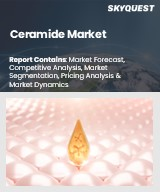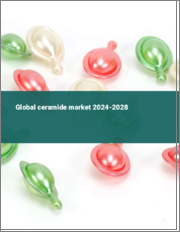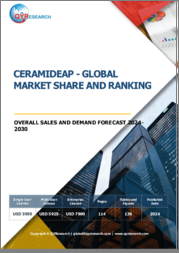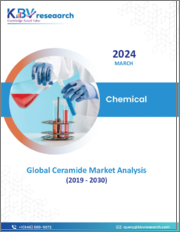
|
시장보고서
상품코드
1702304
세라마이드 시장 규모, 점유율, 동향, 예측 : 유형, 프로세스, 용도, 지역별(2025-2033년)Ceramide Market Size, Share, Trends, and Forecast by Type, Process, Application, and Region, 2025-2033 |
||||||
세라마이드 세계 시장 규모는 2024년에 4억 1,230만 달러로 평가되었습니다. 향후 IMARC Group은 2033년까지 6억 2,880만 달러에 달할 것으로 예상하며, 2025년부터 2033년까지 4.56%의 CAGR을 기록할 것으로 예측하고 있습니다. 현재 아시아태평양이 시장을 독점하고 있으며, 2024년에는 37.3%의 큰 시장 점유율을 차지했습니다. 현재 아시아태평양이 가장 큰 점유율을 차지하고 있는 이유는 피부 건강에 대한 인식 증가, 탄탄한 제조 능력, 정부 지원 정책, 양호한 인구통계학적 요인에 기인합니다.
세라마이드는 세포막에 자연적으로 존재하는 지질로 스핑고신 알코올과 지방산으로 구성되어 있습니다. 세라마이드는 세포의 분화와 세포사멸에 영향을 미치는 다양한 세포 과정을 매개하는 데 도움을 줍니다. 그 결과, 간지방증, 비만에 따른 합병증, 염증 조절, 장애 지방산의 산화에 이용되고 있습니다. 또한, 만성 건조, 환경적 요인, 노화, 피부 손상으로 인한 다양한 피부 및 모발 문제를 치료하기 위해 다양한 화장품 및 퍼스널 제품의 보습제로 사용되고 있습니다.
세라마이드 시장 동향:
습진이나 건선으로 고생하는 사람들의 피부에는 세라마이드가 현저하게 감소되어 있습니다. 따라서 음주와 흡연자의 증가로 인한 습진 및 건선 유병률의 증가는 피부과학 제품에서 세라마이드의 사용을 촉진하는 중요한 요인 중 하나입니다. 이와 함께 자연적으로 존재하는 세라마이드는 나이가 들면서 감소하기 때문에 고령 인구의 증가는 수분 보유력을 높이고 피부의 자연적 장벽을 회복하며 눈에 보이는 노화 징후를 억제하는 세라마이드 기반 제품에 대한 수요를 촉진하고 있습니다. 또한, 동물성 원료를 사용하지 않고 합성으로 생산되는 비건 화장품의 새로운 트렌드가 세라마이드의 채택에 긍정적인 영향을 미치고 있습니다. 이와 더불어, 당뇨병은 전 세계 주요 사망 원인 중 하나이기 때문에 제약 산업에서 세라마이드의 활용이 증가하고 있습니다. 또한, 세라마이드는 인슐린 저항성, B 세포 아포토시스 유도, 인슐린 유전자 발현 감소에 중요한 역할을 하며, 당뇨병과 그 합병증을 관리하기 위한 잠재적 치료 표적을 식별하는 데 도움을 주고 있습니다. 이와는 별도로, 개인들의 건강 인식이 높아짐에 따라 세라마이드는 건강한 삶을 촉진하는 건강보조식품에 널리 사용되고 있습니다.
본 보고서에서 다루는 주요 질문
- 세라마이드의 시장 규모는?
- 세라마이드 시장의 향후 전망은?
- 세라마이드 시장을 이끄는 주요 요인은 무엇인가?
- 세라마이드 시장 점유율이 가장 높은 지역은?
- 세계 세라마이드 시장의 주요 기업은?
목차
제1장 서문
제2장 조사 범위와 조사 방법
- 조사 목적
- 이해관계자
- 데이터 소스
- 1차 정보
- 2차 정보
- 시장 추정
- 상향식 접근
- 하향식 접근
- 조사 방법
제3장 주요 요약
제4장 소개
- 개요
- 주요 업계 동향
제5장 세계의 세라마이드 시장
- 시장 개요
- 시장 실적
- COVID-19의 영향
- 시장 예측
제6장 시장 내역 : 유형별
- 천연
- 합성
제7장 시장 내역 : 프로세스별
- 발효 세라마이드
- 식물 추출물 세라마이드
제8장 시장 내역 : 용도별
- 화장품
- 식품
- 기타
제9장 시장 내역 : 지역별
- 북미
- 미국
- 캐나다
- 아시아태평양
- 중국
- 일본
- 인도
- 한국
- 호주
- 인도네시아
- 기타
- 유럽
- 독일
- 프랑스
- 영국
- 이탈리아
- 스페인
- 러시아
- 기타
- 라틴아메리카
- 브라질
- 멕시코
- 기타
- 중동 및 아프리카
- 시장 내역 : 국가별
제10장 SWOT 분석
- 개요
- 강점
- 약점
- 기회
- 위협
제11장 밸류체인 분석
제12장 Porter's Five Forces 분석
- 개요
- 구매자의 교섭력
- 공급 기업의 교섭력
- 경쟁 정도
- 신규 참여업체의 위협
- 대체품의 위협
제13장 가격 분석
제14장 경쟁 구도
- 시장 구조
- 주요 기업
- 주요 기업 개요
- Air Liquide S.A.
- Anderson Global Group LLC
- Arkema S.A.
- Ashland Inc.
- Cayman Chemical Company
- Croda International Plc
- Evonik Industries AG
- Incospharm Corporation
- Jarchem Industries Inc.
- Kao Corporation
- Toyobo Co. Ltd.
- Vantage Specialty Chemicals
The global ceramide market size was valued at USD 412.3 Million in 2024. Looking forward, IMARC Group estimates the market to reach USD 628.8 Million by 2033, exhibiting a CAGR of 4.56% during 2025-2033. Asia Pacific currently dominates the market, holding a significant market share of 37.3% in 2024. At present, Asia Pacific holds the largest ceramide market share owing to increasing awareness for skin health, robust manufacturing capabilities, supportive government initiatives, and favorable demographics.
Ceramides are lipids found naturally in cell membranes and composed of sphingosine alcohol with fatty acids. They aid in mediating various cellular processes affecting cell differentiation and apoptosis. As a result, they are utilized in liver steatosis, obesity-associated comorbidities, regulating inflammation, and oxidizing impaired fatty acid. Moreover, they are used as a moisturizing agent in various cosmetic and personal products to help treat different skin and hair problems caused by chronic dryness, environmental factors, aging, and skin damage.
Ceramide Market Trends:
Individuals who suffer from eczema and psoriasis have a significant reduction of ceramides in their skin. Thus, the rising prevalence of eczema and psoriasis on account of the increasing number of people that drink and smoke represents one of the key factors catalyzing the usage of ceramides in dermatological products. In line with this, as naturally occurring ceramides decline with age, the growing geriatric population is driving the demand for ceramide-based products to improve water retention, restore the skin's natural barrier, and reduce the visible signs of aging. Additionally, the emerging trend of vegan cosmetics is positively influencing the adoption of ceramides as they are synthetically produced without the use of animal byproducts. Besides this, as diabetes mellitus is one of the leading causes of death worldwide, there is a rise in the utilization of ceramides in the pharmaceutical industry. Furthermore, ceramides play a significant role in insulin resistance, induction of B-cell apoptosis, and the reduction of insulin gene expression, which assists in identifying potential therapeutic targets for managing diabetes mellitus and its complications. Apart from this, due to rising health consciousness among individuals, ceramides are widely being used in supplements that promote a healthier life.
Key Market Segmentation:
Breakup by Type:
- Natural
- Synthetic
Breakup by Process:
- Fermentation Ceramides
- Plant Extract Ceramides
Breakup by Application:
- Cosmetics
- Food
- Others
Breakup by Region:
- North America
- United States
- Canada
- Asia-Pacific
- China
- Japan
- India
- South Korea
- Australia
- Indonesia
- Others
- Europe
- Germany
- France
- United Kingdom
- Italy
- Spain
- Russia
- Others
- Latin America
- Brazil
- Mexico
- Others
- Middle East and Africa
Competitive Landscape:
The competitive landscape of the industry has also been examined along with the profiles of the key players being Air Liquide S.A., Anderson Global Group LLC, Arkema S.A., Ashland Inc., Cayman Chemical Company, Croda International Plc, Evonik Industries AG, Incospharm Corporation, Jarchem Industries Inc., Kao Corporation, Toyobo Co. Ltd. and Vantage Specialty Chemicals.
Key Questions Answered in This Report
- 1.How big is the ceramide market?
- 2.What is the future outlook of the ceramide market?
- 3.What are the key factors driving the ceramide market?
- 4.Which region accounts for the largest ceramide market share?
- 5.Which are the leading companies in the global ceramide market?
Table of Contents
1 Preface
2 Scope and Methodology
- 2.1 Objectives of the Study
- 2.2 Stakeholders
- 2.3 Data Sources
- 2.3.1 Primary Sources
- 2.3.2 Secondary Sources
- 2.4 Market Estimation
- 2.4.1 Bottom-Up Approach
- 2.4.2 Top-Down Approach
- 2.5 Forecasting Methodology
3 Executive Summary
4 Introduction
- 4.1 Overview
- 4.2 Key Industry Trends
5 Global Ceramide Market
- 5.1 Market Overview
- 5.2 Market Performance
- 5.3 Impact of COVID-19
- 5.4 Market Forecast
6 Market Breakup by Type
- 6.1 Natural
- 6.1.1 Market Trends
- 6.1.2 Market Forecast
- 6.2 Synthetic
- 6.2.1 Market Trends
- 6.2.2 Market Forecast
7 Market Breakup by Process
- 7.1 Fermentation Ceramides
- 7.1.1 Market Trends
- 7.1.2 Market Forecast
- 7.2 Plant Extract Ceramides
- 7.2.1 Market Trends
- 7.2.2 Market Forecast
8 Market Breakup by Application
- 8.1 Cosmetics
- 8.1.1 Market Trends
- 8.1.2 Market Forecast
- 8.2 Food
- 8.2.1 Market Trends
- 8.2.2 Market Forecast
- 8.3 Others
- 8.3.1 Market Trends
- 8.3.2 Market Forecast
9 Market Breakup by Region
- 9.1 North America
- 9.1.1 United States
- 9.1.1.1 Market Trends
- 9.1.1.2 Market Forecast
- 9.1.2 Canada
- 9.1.2.1 Market Trends
- 9.1.2.2 Market Forecast
- 9.1.1 United States
- 9.2 Asia-Pacific
- 9.2.1 China
- 9.2.1.1 Market Trends
- 9.2.1.2 Market Forecast
- 9.2.2 Japan
- 9.2.2.1 Market Trends
- 9.2.2.2 Market Forecast
- 9.2.3 India
- 9.2.3.1 Market Trends
- 9.2.3.2 Market Forecast
- 9.2.4 South Korea
- 9.2.4.1 Market Trends
- 9.2.4.2 Market Forecast
- 9.2.5 Australia
- 9.2.5.1 Market Trends
- 9.2.5.2 Market Forecast
- 9.2.6 Indonesia
- 9.2.6.1 Market Trends
- 9.2.6.2 Market Forecast
- 9.2.7 Others
- 9.2.7.1 Market Trends
- 9.2.7.2 Market Forecast
- 9.2.1 China
- 9.3 Europe
- 9.3.1 Germany
- 9.3.1.1 Market Trends
- 9.3.1.2 Market Forecast
- 9.3.2 France
- 9.3.2.1 Market Trends
- 9.3.2.2 Market Forecast
- 9.3.3 United Kingdom
- 9.3.3.1 Market Trends
- 9.3.3.2 Market Forecast
- 9.3.4 Italy
- 9.3.4.1 Market Trends
- 9.3.4.2 Market Forecast
- 9.3.5 Spain
- 9.3.5.1 Market Trends
- 9.3.5.2 Market Forecast
- 9.3.6 Russia
- 9.3.6.1 Market Trends
- 9.3.6.2 Market Forecast
- 9.3.7 Others
- 9.3.7.1 Market Trends
- 9.3.7.2 Market Forecast
- 9.3.1 Germany
- 9.4 Latin America
- 9.4.1 Brazil
- 9.4.1.1 Market Trends
- 9.4.1.2 Market Forecast
- 9.4.2 Mexico
- 9.4.2.1 Market Trends
- 9.4.2.2 Market Forecast
- 9.4.3 Others
- 9.4.3.1 Market Trends
- 9.4.3.2 Market Forecast
- 9.4.1 Brazil
- 9.5 Middle East and Africa
- 9.5.1 Market Trends
- 9.5.2 Market Breakup by Country
- 9.5.3 Market Forecast
10 SWOT Analysis
- 10.1 Overview
- 10.2 Strengths
- 10.3 Weaknesses
- 10.4 Opportunities
- 10.5 Threats
11 Value Chain Analysis
12 Porters Five Forces Analysis
- 12.1 Overview
- 12.2 Bargaining Power of Buyers
- 12.3 Bargaining Power of Suppliers
- 12.4 Degree of Competition
- 12.5 Threat of New Entrants
- 12.6 Threat of Substitutes
13 Price Analysis
14 Competitive Landscape
- 14.1 Market Structure
- 14.2 Key Players
- 14.3 Profiles of Key Players
- 14.3.1 Air Liquide S.A.
- 14.3.1.1 Company Overview
- 14.3.1.2 Product Portfolio
- 14.3.1.3 Financials
- 14.3.1.4 SWOT Analysis
- 14.3.2 Anderson Global Group LLC
- 14.3.2.1 Company Overview
- 14.3.2.2 Product Portfolio
- 14.3.3 Arkema S.A.
- 14.3.3.1 Company Overview
- 14.3.3.2 Product Portfolio
- 14.3.3.3 Financials
- 14.3.3.4 SWOT Analysis
- 14.3.4 Ashland Inc.
- 14.3.4.1 Company Overview
- 14.3.4.2 Product Portfolio
- 14.3.4.3 Financials
- 14.3.4.4 SWOT Analysis
- 14.3.5 Cayman Chemical Company
- 14.3.5.1 Company Overview
- 14.3.5.2 Product Portfolio
- 14.3.6 Croda International Plc
- 14.3.6.1 Company Overview
- 14.3.6.2 Product Portfolio
- 14.3.6.3 Financials
- 14.3.6.4 SWOT Analysis
- 14.3.7 Evonik Industries AG
- 14.3.7.1 Company Overview
- 14.3.7.2 Product Portfolio
- 14.3.7.3 Financials
- 14.3.7.4 SWOT Analysis
- 14.3.8 Incospharm Corporation
- 14.3.8.1 Company Overview
- 14.3.8.2 Product Portfolio
- 14.3.9 Jarchem Industries Inc.
- 14.3.9.1 Company Overview
- 14.3.9.2 Product Portfolio
- 14.3.10 Kao Corporation
- 14.3.10.1 Company Overview
- 14.3.10.2 Product Portfolio
- 14.3.10.3 Financials
- 14.3.10.4 SWOT Analysis
- 14.3.11 Toyobo Co. Ltd.
- 14.3.11.1 Company Overview
- 14.3.11.2 Product Portfolio
- 14.3.11.3 Financials
- 14.3.11.4 SWOT Analysis
- 14.3.12 Vantage Specialty Chemicals
- 14.3.12.1 Company Overview
- 14.3.12.2 Product Portfolio
- 14.3.1 Air Liquide S.A.

















